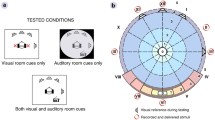Abstract
We propose a novel concept toward interfaces that can provide visually impaired persons with the opportunity to recover the freedom to conceptualize their environment without depending on conventional voice synthesizer systems. Fourteen subjects participated in ten experiments to provide results that evaluated their performances to conceptualize spatial information based on cues in “artificial-sounding” (AS) and “natural-sounding” (NS) tones. The source of AS tones was the digitized sound used by the vOICe Learning Edition, and the source of NS tones was fan noise with analogs in everyday listening. Experimental results revealed that the use of NS tones was essential for improving the conceptualization performance of subjects as the eventual users of novel human–environment interfaces.
Similar content being viewed by others
Explore related subjects
Discover the latest articles, news and stories from top researchers in related subjects.References
WD Jones (2004) ArticleTitleSight for sore ears IEEE Spectrum 41 IssueID2 13–14 Occurrence Handle10.1109/MSPEC.2004.1265119
WW Gaver (1993) ArticleTitleWhat in the world do we hear? An ecological approach to auditory event perception Ecol Psychol 5 1–29 Occurrence Handle10.1207/s15326969eco0501_1
Buxton W (1990) Using our ears: an introduction to the use of nonspeech audio cues. In: Farrell E (ed) Extracting meaning from complex data: processing, display, interaction. Proc SPIE 1259:124–127
Nomura S, Shiose T, Kawakami H, et al. (2004) A novel “sound visualization” process in virtual 3D space: the human auditory perception analysis by ecological psychology approach. Proceedings of the 8th Asia Pacific Symposium on Intelligent and Evolutionary Systems, Cairns, Monash University, Clayton Victoria, Australia, pp 137–149
Shiose T, Ito K, Mamada K (2004) The development of virtual 3D acoustic environment for training “perception of crossability.” Proceedings of the 9th International Conference on Computers Helping People with Special Needs, Paris, LNCS 3118 Springer-Verlag, Berlin, Heidelberg, pp 476–483
Author information
Authors and Affiliations
Corresponding author
Additional information
This work was presented in part at the 11th International Symposium on Artificial Life and Robotics, Oita, Japan, January 23–25, 2006
About this article
Cite this article
Nomura, S., Tsuchinaga, M., Nojima, Y. et al. Novel nonspeech tones for conceptualizing spatial information. Artif Life Robotics 11, 13–17 (2007). https://doi.org/10.1007/s10015-006-0390-z
Received:
Accepted:
Published:
Issue Date:
DOI: https://doi.org/10.1007/s10015-006-0390-z




